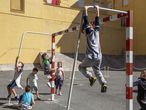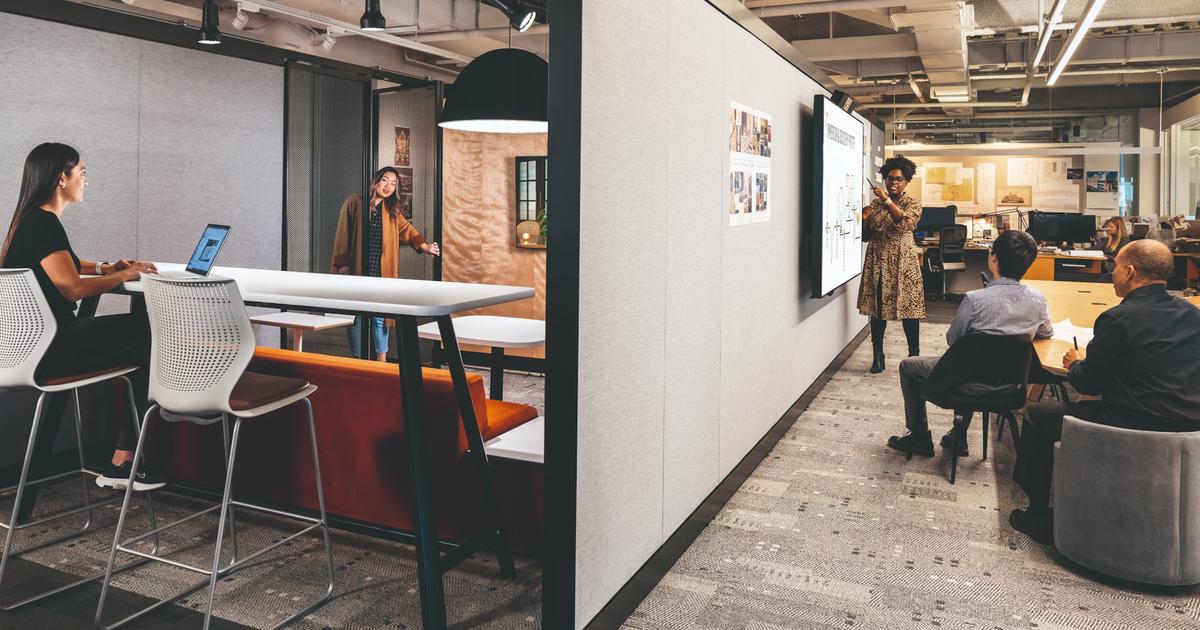Look beyond the school building to expand educational spaces across the playground, street, or park; and that these educational spaces won suppose, in addition to increasing the pedagogical possibilities, benefits in terms of health and sustainability. This is what is achieved with the renaturation of schoolyards according to Mamen Artero Borruel, a member of the collective of architects El Globus Vermell, whose objective is to empower people in the creation of healthier and more sustainable built environments. “With the renaturation of the courtyards, the aim is to transform the schoolyard into a garden, into a park. In a space rich in textures, shadows, and places to be, talk, play, dream ... We can re-naturalize with simple planters,as the first step of an organized community with a purpose and a holistic view of the implications that it entails at the pedagogical, social, environmental, ecological or health level ”, he explains to El País.
More information
Half an hour of school recess: is it enough for the children to vent?
Egalitarian patios against 'soccercentrism': this is how school recess should be
To analyze the situation and the challenges of this transformation, the 'Renaturalization of Educational Spaces' conference was held on May 12 and 13 in Madrid, framed within the informative project
Patios x el clima
, which in line with the objectives for the fight against climate change, seeks to provide tools for the care of the environment from educational centers through the transformation of their outdoor spaces.
During them, various local and regional administrations presented their action plans from the perspective of understanding this change as a tool for physical and social transformation, moving towards the construction of more resilient cities.
"More and more administrations - both regional and local - are committed to reviewing educational infrastructures and their outdoor space to add it to the green infrastructure of their cities," says Artero.
An investment in health
Carolyn Daher, coordinator of ISGlobal's Urban Planning, Environment and Health Initiative, explains that having contact with nature has multiple benefits throughout life. "We have scientific evidence that children who play in nature have better mental health and better physical health as adults at all levels." On the one hand, on a physical level, a natural space allows, according to the expert, greater physical activity, which makes it easier to comply with the WHO recommendations regarding exercise. In this sense, the WHO launched in 2020 a new physical activity guide with a very clear motto: "Every movement counts." The guide offers a series of recommendations for all age groups to improve health.In the case of children and adolescents, an average of 60 minutes a day is recommended. “There is no formula that tells us how much time they have to spend in nature, but there is an official recommendation regarding physical activity. If we want them to comply with this recommendation, it would be very positive if it were in natural environments due to the benefits that are added, ”says Daher.
On the other hand, play in more natural environments also has effects on mental and cognitive health: “It involves social and emotional learning, encourages curiosity and has an impact on gender equality - natural patios tend to be more inclusive - and in raising awareness at the community and environmental level. In addition, it provides protection factors and reduces risk factors by having better air quality and less noise ”.
Children, especially those living in urban settings, lack physical contact with plants and vegetation, and spend more time indoors than is desirable. This is influenced by various factors such as sedentary lifestyle, mobility model, distribution of public space or families' perception of risk. Factors that have direct consequences for your health: childhood obesity, muscle weakness, or mental health problems such as anxiety, depression, or aggressive behaviors. “Children have less and less opportunities to explore and less autonomy, and they have poorer health. Why is it interesting to intervene in the schoolyard to change this? Because in Spain the vast majority of children go to school five days a week for a large part of the year.This allows us to have an accessible environment in which to introduce natural elements effortlessly, ”says Daher.
Another issue is the risk of injuries and accidents that is perceived when talking about renaturation. For Carolyn Daher, although it has been proven that the most dangerous in a yard is asphalt and slides, the perception that continues to prevail is that logs, a pond of water or sticks are more dangerous. “We perceive things that are not dangerous as dangerous, and vice versa, we perceive things that are not so safe as safe. The problem also comes with the regulations: it is forced to have a large surface of cement that is usually used for football. For a school to ask for this to be broken, for a change to take place, it costs a lot ”, he says.
An interesting project on taking “healthy risks” is Anji Play, developed by teacher Cheng Xueqin and carried out in 130 public schools in the country, focused on a change in approach to early childhood education. Its philosophy focuses on discovering the child's abilities through trust, experimentation and offering the conditions and materials that allow them to acquire safe risks, according to their development and abilities. “Children learn by playing. And they learn through trial and error, they must know how far they go, what they are capable of with respect to psychomotor skills. These learning opportunities must be offered to them adapted to their safety according to their age. Namely,they must have “healthy” risks within reach and these are those that adapt to the level of development of the children ”, explains Daher.
The ISGlobal coordinator regrets that whenever the issue of the renaturation of schoolyards is raised, the issue of the cost it entails comes up. This for her is a necessary investment: “We must change the mentality and see it not as a cost but as an investment in health, well-being, learning and equity. In health, prevention is much more interesting, and if we build environments that we know are good for health, and that prevent diseases, we will have savings in the long run ”. Mamen Artero recalls that the important thing is that they be “interventions where all the agents involved (families, management team, faculty, students, local administration, neighborhood entities, sports or recreational-didactic entities) work in a participatory and consensual manner in making decisions. decisions that entail these transformations ”.Also that "changes must occur in a staggered manner and in phases, so that time allows adjusting uses, redirecting projects, analyzing, evaluating and intervening again."
Children's right to greener and more sustainable spaces
Schoolyards can become a first step to achieve greener and more sustainable cities.
“Contact with nature and access to the city's green infrastructure should be considered a fundamental right of the population, just as education is today.
And in this sense, the set of educational centers is presented as a fantastic opportunity to increase the naturalized square meters of our cities ”, argues Mamen Artero Borruel.
Daher shares that idea, for whom it would be interesting for schoolyards to be open to citizens in order to be able to enjoy a greater number of green areas in the urban environment;
something especially important in the case of the most vulnerable people.
Daher points out that renaturalizing the patio is not only a physical transformation of the exterior spaces of the schools, but that there must also be a change in the pedagogical methods so that these spaces are incorporated into learning. "We need a new look at the school paradigm because nature not only offers many opportunities for learning, but also enriches the educational experience and the evolution of us as a society."
In a context such as the current one, marked by the challenges derived from the climate crisis, direct contact with green environments can promote awareness of the need to care for nature.
“It is said that we love what we know and we take care of what we love.
That is why it is necessary to allow the development of people in natural environments that involve significant experiences.
And that means continuing to work from the administrations to make these new scenarios possible ”, he concludes.
Sabina Infant School, a pilot project in Madrid
The Sabina Infant School, located in the Madrid neighborhood of Moratalaz, is one of the centers that have opted for the renaturalization of its outdoor spaces. Cristina de la Calle, pedagogical coordinator of the school, tells that when they arrived at the school they realized that the interior spaces were very designed for ages 0-3 years, but instead “the exteriors were hard, cold and artificial that had little to do with our educational project ”. This led them to propose a project of change that they hope to be able to carry out in the coming months. "Thanks to the 'Patios x el clima' project, the school will have the possibility of having adequate gardens where the boys and girls of this stage can have an integral development," he says. "
Among the advantages that De la Calle finds in renaturalizing the patios are “quality time outdoors, having the possibility of being inside or outside the classroom according to their needs or preferences, experimenting with the changing reality that nature offers, practicing spontaneous games with natural materials or socializing in a more appropriate way, with less conflict between boys and girls ”.
The Sabina team is part of a working group created through the Educar Hoy por un Madrid más Sostenible program in the 2019/2020 academic year.
This group, made up of very diverse people, counting among others with the Environment area, the Education area of Madrid, the Basurama collective and educators from several nursery schools, has launched after two years of work the Wild Patios guide with the The objective of being a model to follow in the construction and adaptation of the exterior areas of future nursery schools, as well as being a technical and theoretical tool to improve and transform existing ones.
You can follow De mamas & de papas on
,
or sign up here to receive
our weekly newsletter
.


/cloudfront-eu-central-1.images.arcpublishing.com/prisa/YXV2XXPRIRGLBCZD37DUIOI5MY.jpg)





/cloudfront-eu-central-1.images.arcpublishing.com/prisa/ACJVKI3Z5RDEHNMZXVN5JJZOVM.jpg)
